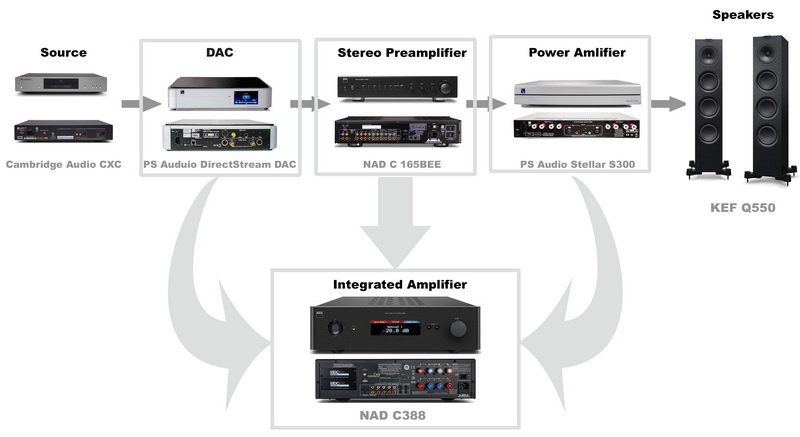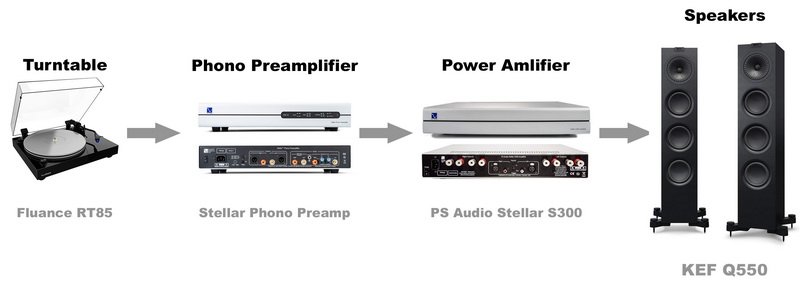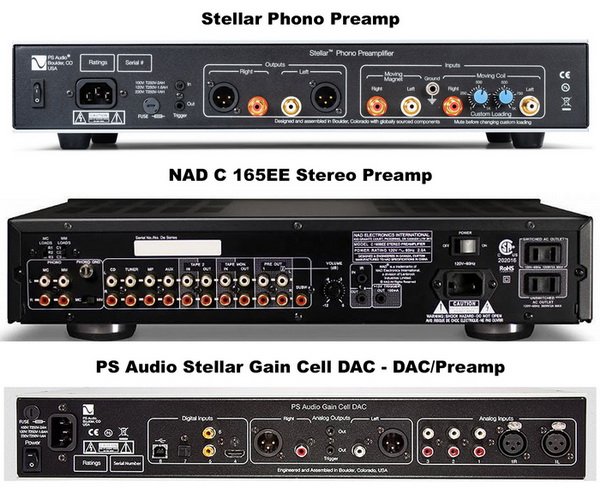Does anybody buy separates nowadays? Using separate preamp and amp is not as common today as it was a decade or two ago, but does that mean that preamps are redundant? Why would you buy separates when you can get everything in one box? We are here today to answer all those questions and to find out how important preamps really are.
Page Contents
What is a Preamp?
A preamp is an important component in a home audio system. It is an ingenious invention and a device that has an unavoidable and important role in signal reception and signal processing. Its role is to be a “meeting point” that processes and distributes the signal that is directed to the power amp, and to the loudspeakers as a final destination. There are many varieties of preamps that are used for different purposes.
A Home Preamp
When you just call it a preamp, it usually falls into the category of “separates”.
What does a separate mean? It means that the preamp is an external, separate unit from other audio components, such as a power amp, radio, gramophone, etc.
A preamp can be a separate unit in a dedicated box. That separate preamp will be connected to a power amp, which then sends the signal to the loudspeakers.

Example of a stereo system made of separate units
Next, there is an integrated amp, which contains a preamp and a power amp in one box. Sometimes, it also has a DAC built-inside. There are also variations with DACs, preamps, and amps. For example, some units combine DAC and preamp in one box.

DAC/preamp – DAC and preamp inside one unit

Integrated amp – DAC, preamp, and amp inside one unit
A receiver is also a device that has a preamp built-inside. There are two types of receivers: stereo receiver and AV receiver. The stereo receiver contains a radio, preamp, and an amp inside one unit. The purpose of a stereo receiver is only audio processing. AV receiver is mostly used in home theater setups. The AVR (audio/video receiver) contains various input and output connections for audio and video sources: HDMI, analog RCA, Component video IN/OUT, Coaxial, Optical, etc. It can receive the signal from any audio or video source connected to it. It processes those signals, amplifies audio signals, and sends them to speakers, and video signals to a display, such as TV, monitor, projector, etc.
The most common use of AV receivers in households is for music and home theater use. Integrated amps are quite popular, but true audiophiles still insist on separate units when it comes to music reproduction (DAC, preamp, amp).
What does a preamp do?
Preamplifiers take the analog signal from other audio components, for example, a signal from a turntable or a CD player connected to a DAC, process and enhance the signal (without any sound or tone filters), and send it towards the power amplifier which then passes that signal to loudspeakers.
Special preamplifiers of higher sensitivity are also used. Their purpose is to take the weak analog signal that comes from the gramophone/turntable and adapt it for the classic preamplification. Home audio preamps usually have integrated gramophone sections (phono inputs). When we want to listen to vinyl, we just have to use the knob selector and switch it to “PHONO” input.

Stereo system with a turntable and phono preamp
What kind of inputs do preamps have?
Preamps typically contain a certain amount of input channels (inputs for various source devices) enough for a standard number of home audio components, such as tuners (radio receivers), CD players, turntables, etc.
Most preamps have multiple RCA analog inputs. Some may even have a dedicated phono input (which means that you don’t need a separate phono preamp). DAC/preamps will also have digital audio inputs for connecting digital sources (optical inputs, coaxial inputs, USB inputs, etc.). Some may even have streaming capabilities (Ethernet port and wi-fi connectivity).

Different kinds of preamps have different types of inputs
Some preamps also have tone filters for sound processing, mostly for regulating high, midrange, and low frequencies. These filters serve as an aid for enhancing poor-quality signals.
Next to the visually dominant potentiometer for sound volume control, there is also a pan knob, the so-called “balance”, which regulates the distribution of sound between the left and right channels.
Advantages of a preamp/amp system over an integrated amp
Will I get better overall audio quality if I use separate components? That’s one of the most common questions when it comes to preamps, their purpose in a home stereo system, and the effect they have on the overall performance.
The short answer would be YES. Using a separate preamp and power amp reduces the distortion and provides you with a clearer audio signal, which results in more transparent audio reproduction.
Using separate units gives you more freedom and flexibility – it allows you to combine components made by different manufacturers and find your preferred sound signature.
The most important advantage of using separate units is the fact that each unit has a separate power supply. In integrated amps, the preamp section shares the power supply with a power-hungry amplifier section and that often results in poor performance of the preamp section (because of the interference). When two units are separated, the chance of interference is eliminated.
Conclusion
Considering what your plans are for your home audio, there are plenty of reasons for having or not having a separate preamp. Most audiophiles tend to have separates – they use a separate component for every part of the job. That’s the best way to eliminate interference caused by shared power supplies and the best way to get the cleanest possible audio output.
However, today’s integrated amps, especially high-end amps, have very clean output and deliver pretty great overall performance. So, if you’re a regular user, buying an integrated amp is maybe a smarter option. And it’s also much easier – the installation is more straightforward, you don’t have to think about additional cables, or about combining amp and preamp.
Experimenting with equipment is a fun activity, and if you have the time, you should definitely visit your local audio store and try different combinations of amps and preamps. That’s the best way to find out whether you need separate units or not.

